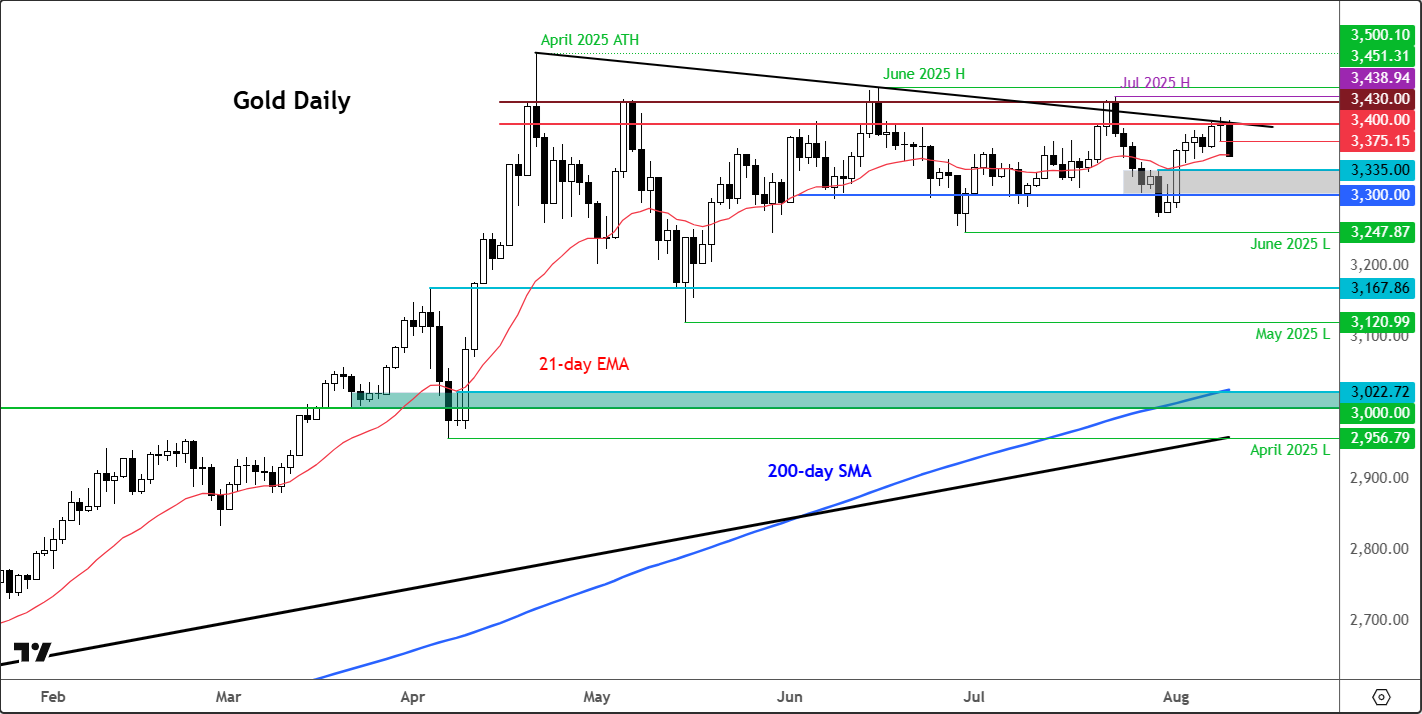Gold forecast: Haven demand falls amid hopes of Ukraine-Russia ceasefire
August 11, 2025 15:04- Gold forecast dented with prices retreating 1% as Ukraine peace hopes dent safe-haven demand
- All eyes on US inflation data this week, starting with CPI on Tuesday
- Fed rate cut bets keep downside limited despite equity market rally
Gold prices eased in early Monday trading, shedding over 1% as signs of de-escalation in the Ukraine conflict dampened safe haven buying. Silver also softened. The pullback comes after a volatile Friday, when tariff confusion drove futures to fresh highs but left spot gold anchored near $3,400, a level that has now proven as critical resistance ahead of Tuesday’s US CPI data. While last week’s gains have been largely erased, expectations for multiple Fed rate cuts this year is so far preventing us from declaring a bearish gold forecast. More technical evidence of a top is needed for that to happen.
👉 Read our gold forecast for second half of 2025 here
Gold forecast: Ukraine ceasefire hopes weigh on XAU/USD
Monday’s losses meant the precious metal erased nearly all of the gains made in the previous week, when weakness in US dollar and data kept the appetite for gold intact even though there was a sharp increase in risk appetite, which saw global indices rally sharply with some hitting new all-time highs. But at the start of this week, gold investors are having second thoughts, after Trump’s announcement that he would meet Putin in Alaska on August 15 to negotiate a possible end to the war. Today’s drop is not insignificant, but prices are still stuck inside the existing ranges. The downside has been limited so far due to persistent trade uncertainty and expectations for Federal Reserve easing rates twice or possibly three times later this year, starting in September.
US inflation data to take centre stage this week
Looking ahead, we have key US inflation and retail sales data to look forward to this week, which could impact gold prices in event of major surprises. The Consumer Price Index (CPI) data will be released on Tuesday, followed by the Producer Price Index (PPI) on Thursday. On Friday, attention will shift to the University of Michigan’s Inflation Expectations survey, alongside the UoM consumer sentiment, retail sales, the Empire State Manufacturing Index, and industrial production data.
Although the Federal Reserve’s dual mandate includes fostering maximum employment, its other key goal is price stability, and specifically maintaining inflation near the 2% long-term target. With growing market concerns about future inflation—partly driven by the potential inflationary effects of Trump’s tariffs—investors are eager to see if companies are beginning to pass on higher input costs to consumers. So far, this hasn’t happened, as CPI has missed forecasts for the last five months. But could that trend now be changing?
The upcoming PPI report is also crucial, as it feeds into the Fed’s preferred inflation measure—the core Personal Consumption Expenditures (PCE) index—set to be released later this month. While Friday’s UoM inflation expectations report may attract attention, the main focus is likely to be on retail sales. A combination of weaker consumer spending and stronger inflation could heighten concerns about stagflation.
Fed seen cutting in September
Recently, a string of weaker-than-expected employment figures reignited expectations that the Federal Reserve may be forced to begin cutting interest rates as early as September, potentially followed by another cut in October. The December meeting is currently seen as a toss-up. Additional downward pressure on the dollar has come from softer ISM services and manufacturing PMI readings, as well as rising jobless claims. Reflecting this shift, several Fed officials have recently acknowledged the possibility of multiple rate cuts this year, even as inflation risks persist. This has kept the gold forecast supported, despite a sharp rally in the equity markets.
Gold key levels to watch

There is a clear bearish trend line emerging on gold, derived from connecting the highs made in April ($3,500), June ($3,451) and July ($3,439). This trend line was tested on Friday at around $3,400, and again at the Asian open overnight. The trend line has held. We still need to form lower lows to confirm at least a near-term top is in before declaring a bearish gold forecast, but don’t take any bearish signals lightly given how expensive gold has become and the fact that the bullish momentum has stalled.
But should that trend line break at some point this week, and we move north of $3400 resistance, then this could potentially pave the way for new all-time highs in spot gold prices.
Support is now seen around $3,335 initially, ahead of $3,300 next. The June low of $3,248 could be tested if we see a potential close below the $3,300 in the coming days, as that could tip the balance towards the bearish side of things.
— Written by Fawad Razaqzada, Market Analyst
Follow Fawad on Twitter @Trader_F_R